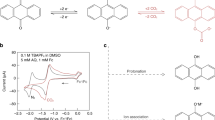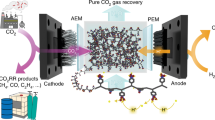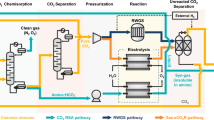Abstract
Electrochemical carbon-capture technologies, with renewable electricity as the energy input, are promising for carbon management but still suffer from low capture rates, oxygen sensitivity or system complexity1,2,3,4,5,6. Here we demonstrate a continuous electrochemical carbon-capture design by coupling oxygen/water (O2/H2O) redox couple with a modular solid-electrolyte reactor7. By performing oxygen reduction reaction (ORR) and oxygen evolution reaction (OER) redox electrolysis, our device can efficiently absorb dilute carbon dioxide (CO2) molecules at the high-alkaline cathode–membrane interface to form carbonate ions, followed by a neutralization process through the proton flux from the anode to continuously output a high-purity (>99%) CO2 stream from the middle solid-electrolyte layer. No chemical inputs were needed nor side products generated during the whole carbon absorption/release process. High carbon-capture rates (440 mA cm−2, 0.137 mmolCO2 min−1 cm−2 or 86.7 kgCO2 day−1 m−2), high Faradaic efficiencies (>90% based on carbonate), high carbon-removal efficiency (>98%) in simulated flue gas and low energy consumption (starting from about 150 kJ per molCO2) were demonstrated in our carbon-capture solid-electrolyte reactor, suggesting promising practical applications.
This is a preview of subscription content, access via your institution
Access options
Access Nature and 54 other Nature Portfolio journals
Get Nature+, our best-value online-access subscription
$29.99 / 30 days
cancel any time
Subscribe to this journal
Receive 51 print issues and online access
$199.00 per year
only $3.90 per issue
Buy this article
- Purchase on Springer Link
- Instant access to full article PDF
Prices may be subject to local taxes which are calculated during checkout




Similar content being viewed by others
Data availability
The data that support the plots in this paper and other findings of this study are available from the corresponding author on request.
References
Haszeldine, R. S. Carbon capture and storage: how green can black be? Science 325, 1647–1652 (2009).
Digdaya, I. A. et al. A direct coupled electrochemical system for capture and conversion of CO2 from oceanwater. Nat. Commun. 11, 4412 (2020).
Sharifian, R., Wagterveld, R. M., Digdaya, I. A., Xiang, C. & Vermaas, D. A. Electrochemical carbon dioxide capture to close the carbon cycle. Energy Environ. Sci. 14, 781–814 (2021).
Renfrew, S. E., Starr, D. E. & Strasser, P. Electrochemical approaches toward CO2 capture and concentration. ACS Catal. 10, 13058–13074 (2020).
Eisaman, M. D., Alvarado, L., Larner, D., Wang, P. & Littau, K. A. CO2 desorption using high-pressure bipolar membrane electrodialysis. Energy Environ. Sci. 4, 4031–4037 (2011).
Gurkan, B. et al. Perspective and challenges in electrochemical approaches for reactive CO2 separations. iScience 24, 103422 (2021).
Xia, C., Xia, Y., Zhu, P., Fan, L. & Wang, H. Direct electrosynthesis of pure aqueous H2O2 solutions up to 20% by weight using a solid electrolyte. Science 366, 226–231 (2019).
Leung, D. Y. C., Caramanna, G. & Maroto-Valer, M. M. An overview of current status of carbon dioxide capture and storage technologies. Renew. Sustain. Energy Rev. 39, 426–443 (2014).
Metz, B., Davidson, O., de Coninck, H., Loos, M. & Meyer, L. (eds) IPCC Special Report on Carbon Dioxide Capture and Storage (Cambridge Univ. Press, 2005).
Keith, D. W., Holmes, G., St. Angelo, D. & Heidel, K. A process for capturing CO2 from the atmosphere. Joule 2, 1573–1594 (2018).
Rochelle Gary, T. Amine scrubbing for CO2 capture. Science 325, 1652–1654 (2009).
Tan, W.-L., Ahmad, A. L., Leo, C. P. & Lam, S. S. A critical review to bridge the gaps between carbon capture, storage and use of CaCO3. J. CO2 Util. 42, 101333 (2020).
Trickett, C. A. et al. The chemistry of metal–organic frameworks for CO2 capture, regeneration and conversion. Nat. Rev. Mater. 2, 17045 (2017).
Lyu, H., Li, H., Hanikel, N., Wang, K. & Yaghi, O. M. Covalent organic frameworks for carbon dioxide capture from air. J. Am. Chem. Soc. 144, 12989–12995 (2022).
McDonald, T. M. et al. Cooperative insertion of CO2 in diamine-appended metal-organic frameworks. Nature 519, 303–308 (2015).
Voskian, S. & Hatton, T. A. Faradaic electro-swing reactive adsorption for CO2 capture. Energy Environ. Sci. 12, 3530–3547 (2019).
Datta, S. et al. Electrochemical CO2 capture using resin-wafer electrodeionization. Ind. Eng. Chem. Res. 52, 15177–15186 (2013).
Eisaman, M. D. et al. CO2 extraction from seawater using bipolar membrane electrodialysis. Energy Environ. Sci. 5, 7346–7352 (2012).
Liu, Y., Ye, H.-Z., Diederichsen, K. M., Van Voorhis, T. & Hatton, T. A. Electrochemically mediated carbon dioxide separation with quinone chemistry in salt-concentrated aqueous media. Nat. Commun. 11, 2278 (2020).
Ranjan, R. et al. Reversible electrochemical trapping of carbon dioxide using 4,4′-bipyridine that does not require thermal activation. J. Phys. Chem. Lett. 6, 4943–4946 (2015).
Willauer, H. D., DiMascio, F., Hardy, D. R. & Williams, F. W. Feasibility of CO2 extraction from seawater and simultaneous hydrogen gas generation using a novel and robust electrolytic cation exchange module based on continuous electrodeionization technology. Ind. Eng. Chem. Res. 53, 12192–12200 (2014).
Eisaman, M. D. et al. CO2 separation using bipolar membrane electrodialysis. Energy Environ. Sci. 4, 1319–1328 (2011).
Way, J. et al. Low voltage electrochemical process for direct carbon dioxide sequestration. J. Electrochem. Soc. 159, B627–B628 (2012).
Park, H. S. et al. CO2 fixation by membrane separated NaCl electrolysis. Energies 8, 8704–8715 (2015).
Youn, M. H. et al. Carbon dioxide sequestration process for the cement industry. J. CO2 Util. 34, 325–334 (2019).
McCallum, C. et al. Reducing the crossover of carbonate and liquid products during carbon dioxide electroreduction. Cell Rep. Phys. Sci. 2, 100522 (2021).
Sun, Y. et al. Advancements in cathode catalyst and cathode layer design for proton exchange membrane fuel cells. Nat. Commun. 12, 5984 (2021).
Li, J. et al. Efficient electrocatalytic CO2 reduction on a three-phase interface. Nat. Catal. 1, 592–600 (2018).
Wang, H. et al. Direct and continuous strain control of catalysts with tunable battery electrode materials. Science 354, 1031–1036 (2016).
Pande, N. et al. Electrochemically induced pH change: time-resolved confocal fluorescence microscopy measurements and comparison with numerical model. J. Phys. Chem. Lett. 11, 7042–7048 (2020).
Lee, M. J. et al. Understanding the bifunctional effect for removal of CO poisoning: blend of a platinum nanocatalyst and hydrous ruthenium oxide as a model system. ACS Catal. 6, 2398–2407 (2016).
Liu, J. et al. Tackling CO poisoning with single-atom alloy catalysts. J. Am. Chem. Soc. 138, 6396–6399 (2016).
Peng, L., Shang, L., Zhang, T. & Waterhouse, G. I. N. Recent advances in the development of single-atom catalysts for oxygen electrocatalysis and zinc–air batteries. Adv. Energy Mater. 10, 2003018 (2020).
Chung Hoon, T. et al. Direct atomic-level insight into the active sites of a high-performance PGM-free ORR catalyst. Science 357, 479–484 (2017).
Li, F. et al. Boosting oxygen reduction catalysis with abundant copper single atom active sites. Energy Environ. Sci. 11, 2263–2269 (2018).
Wu, Z.-Y. et al. Electrochemical ammonia synthesis via nitrate reduction on Fe single atom catalyst. Nat. Commun. 12, 2870 (2021).
Yin, P. et al. Single cobalt atoms with precise N-coordination as superior oxygen reduction reaction catalysts. Angew. Chem. Int. Ed. 55, 10800–10805 (2016).
Holmes, G. & Keith, D. W. An air–liquid contactor for large-scale capture of CO2 from air. Philos. Trans. R. Soc. A Math. Phys. Eng. Sci. 370, 4380–4403 (2012).
Stolaroff, J. K., Keith, D. W. & Lowry, G. V. Carbon dioxide capture from atmospheric air using sodium hydroxide spray. Energy Environ. Sci. 42, 2728–2735 (2008).
Mahmoudkhani, M. & Keith, D. W. Low-energy sodium hydroxide recovery for CO2 capture from atmospheric air—thermodynamic analysis. Int. J. Greenh. Gas Control 3, 376–384 (2009).
Rahimi, M. et al. Carbon dioxide capture using an electrochemically driven proton concentration process. Cell Rep. Phys. Sci. 1, 100033 (2020).
Bakhmutova-Albert, E. V., Yao, H., Denevan, D. E. & Richardson, D. E. Kinetics and mechanism of peroxymonocarbonate formation. Inorg. Chem. 49, 11287–11296 (2010).
Shin, H., Hansen, K. U. & Jiao, F. Techno-economic assessment of low-temperature carbon dioxide electrolysis. Nat. Sustain. 4, 911–919 (2021).
Wang, X. et al. Efficient electrosynthesis of n-propanol from carbon monoxide using a Ag–Ru–Cu catalyst. Nat. Energy 7, 170–176 (2022).
Xia, Y. et al. Highly active and selective oxygen reduction to H2O2 on boron-doped carbon for high production rates. Nat. Commun. 12, 4225 (2021).
Acknowledgements
This work was supported by Rice University, NSF (grant no. 2029442), the Robert A. Welch Foundation (grant no. C-2051-20200401) and the David and Lucile Packard Foundation (grant no. 2020-71371). This work was performed in part at the Shared Equipment Authority (SEA) at Rice University. The EXAFS data were collected at the SXRMB beamline at the Canadian Light Source, a national research facility of the University of Saskatchewan, which is supported by the Canada Foundation for Innovation (CFI), the Natural Sciences and Engineering Research Council (NSERC), the National Research Council (NRC), Canadian Institutes of Health Research (CIHR), Government of Saskatchewan and the University of Saskatchewan.
Author information
Authors and Affiliations
Contributions
H.W. supervised the project. H.W. and P.Z. designed the reactor system. Z.-Y.W. and P.Z. developed and performed catalyst synthesis. P.Z., C.D., A.E., Y.F., Z.F. and J.Y.(T.)K. conducted the electrochemical tests and related data processing. P.Z., F.-Y.C., A.E., M.S., Y.X. and T.-U.W. carried out materials characterization. P.Z., Z.-Y.W, A.E., T.A.H. and H.W. wrote the manuscript, with input from all authors.
Corresponding author
Ethics declarations
Competing interests
P.Z., J.Y.(T.)K. and H.W. are the inventors listed on a US patent application based on this study by Rice University.
Peer review
Peer review information
Nature thanks Ian Sullivan, Ajayan Vinu and the other, anonymous, reviewer(s) for their contribution to the peer review of this work.
Additional information
Publisher’s note Springer Nature remains neutral with regard to jurisdictional claims in published maps and institutional affiliations.
Supplementary information
Supplementary Information
Supplementary Discussions 1–4, Supplementary Tables 1 and 2, Supplementary Figs. 1–43 and Supplementary References—see contents page for details
Rights and permissions
Springer Nature or its licensor (e.g. a society or other partner) holds exclusive rights to this article under a publishing agreement with the author(s) or other rightsholder(s); author self-archiving of the accepted manuscript version of this article is solely governed by the terms of such publishing agreement and applicable law.
About this article
Cite this article
Zhu, P., Wu, ZY., Elgazzar, A. et al. Continuous carbon capture in an electrochemical solid-electrolyte reactor. Nature 618, 959–966 (2023). https://doi.org/10.1038/s41586-023-06060-1
Received:
Accepted:
Published:
Issue Date:
DOI: https://doi.org/10.1038/s41586-023-06060-1
This article is cited by
-
Engineering redox-active electrochemically mediated carbon dioxide capture systems
Nature Chemical Engineering (2024)
-
Multi-scale physics of bipolar membranes in electrochemical processes
Nature Chemical Engineering (2024)
-
Recent advances, challenges, and perspectives on carbon capture
Frontiers of Environmental Science & Engineering (2024)
-
Electrifying the future: the advances and opportunities of electrocatalytic carbon dioxide reduction in acid
Science China Chemistry (2023)
Comments
By submitting a comment you agree to abide by our Terms and Community Guidelines. If you find something abusive or that does not comply with our terms or guidelines please flag it as inappropriate.



